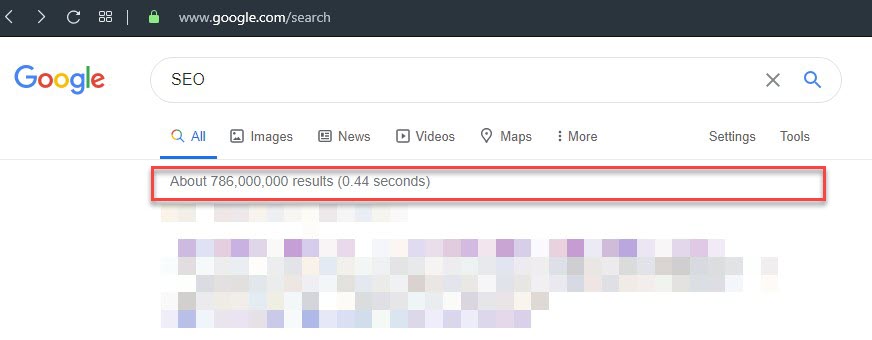Despite the 786 MILLION search results Google brings us when searching for “SEO”, the first page is more than enough to shape a perfect idea about this term.
For content creators, it is not just for their content to appear within Google’s results. But certainly to appear within the very first pages. Here is when SEO techniques come into play.

1. Overview
Let us ask the following question:
How many times have you ever jumped to page 10 in search results? or even to page 2 or 3?
Most statistics indicate that the majority of clicks (CTR) take place on results within the very first search engine result page (SERP).
In this context, SEO techniques make it more efficient for content to be ranked in higher positions within query results. But keep in mind, whatever the SEO techniques you are using to be ranked first, your content remains the king!

2. What is SEO
SEO (Search Engine Optimization) refers to the process of enhancing websites and web pages to be more visible and discoverable by search engines.
In other words, it combines additions and modifications that can be applied to make online resources easily indexable and accessible by search engines.
That said, it is not enough for your website to be user-friendly and mobile-friendly, it needs to be search-engine friendly as well.
The fact that any blogger or content creator needs to know is:
The higher the search ranking you achieve, the more traffic you receive. And eventually, the more you achieve your goals and earn from your online content.
3. Search Engine Algorithms
As key components of all search engines, we should take a look at the two main algorithms behind most search engines: HITS, and PageRank.
In general, search engines deal with each webpage as a node within a network of other nodes/pages. Where each node refers to other nodes using links.
3.1. HITS Algorithm (Hub and Authority)
Used by Ask.com, the HITS algorithm (Hyperlink-Induced Topic Search) employs two main concepts: Hub and Authority.
As defined by Merriam-Webster, Hub is the central part of a circular object. Likewise, HITS defines the hub of a webpage as the collection of all webpages that this page refers to (has links to).
On the other hand, the Authority of a webpage is the collection of webpages that refer to this page (has links to this page).
Consequently, the higher hub and authority score of a webpage, the higher it is ranked within search engines.
3.2. Google PageRank Algorithm
PageRank algorithm, developed and used by Google, doesn’t employ the terms Hub and Authority. In contrast, it depends on both the number and quality of links referring to a webpage to rank this page.
Hence, the importance of a webpage is subject to the quality and quantity of referring links. The more quality links a webpage retains, the better chance it has to rank first in search results.
For more details on how PageRank works, check the following illustration by Zach Star:
3.3. SEO and Ranking Algorithms
In fact, mentioned search engine algorithms are very complex in nature and consider too many factors to determine the importance of web pages. However, they describe the underlying processes behind most search engines.
Accordingly, since most search engine algorithms focus on links coming from other sites to assess webpages, why should we care about our content quality and implement SEO techniques on our pages?
The answer is simply to:
- Help search engines find, access, and identify the webpage more easily and efficiently.
- More importantly, to provide quality resources so others would be willing to link back to our content.
Nevertheless, there still be many factors that could impact page ranking in search engine results.
4. On-Page SEO vs Off-Page SEO
In the context of search engine strategies, we can classify SEO concepts into two main categories. Both are very important to reach the success of ranking campaigns:
4.1. On-Page SEO
Also known as On-Site SEO, On-Page SEO refers to the optimization that website owners can directly apply to their web pages. It is a checklist of modifications and enhancements that affect different parts of the webpage content and structure.
On-Page SEO techniques are the most important improvements as they are totally under the website owner’s control. These enhancements include techniques such as keywords, metadata, headings, sitemaps, and many others.
4.2. Off-Page SEO
Off-Page SEO (also known as Off-Site SEO) indicates a completely different set of concepts. It focuses on increasing the website/domain authority by gaining links from other trusted websites.
The Off-Page concept is strongly connected to HITs and PageRank algorithms mentioned above. As a result, Off-Page techniques are the most effective in targeting top-rank searching positions.
However, Off-Page SEO is a bit more difficult to achieve because it is working outside the scope of website owners/editors. Off-Page factors include link building, social media marketing, branding, etc.
5. Content Creation Strategies
Although SEO techniques are effective to achieve better rankings, the content itself is a primary factor as well. In terms of content creation methodologies, we can recognize two different approaches:

5.1. Keywords-Driven Content Creation Approach (KD-CCA)
For most content creators, content creation is a keyword race in the first place. Where time is spent on finding search queries (keywords) of the highest searching potentials and lowest competition.
We will refer to this strategy as Keyword-Driven Content Creation Approach (KD-CCA). The main idea behind this approach is to do a comprehensive research before starting a new post or article. This research aims at finding a small set of related keywords.
This process might include using free (or even paid) tools to help reveal these keywords. Afterward, the next step is to write a post that revolves around the targeted keywords and, then, apply SEO techniques to it.
5.2. Quality-Driven Content Creation Approach (QD-CCA)
According to IT experts, understanding the ultimate goals of search engine algorithms leads to a slightly different approach. To satisfy the need of their users, search engines try to bring the most relevant answers to the user’s queries. With that in mind, the higher quality answers the algorithm retrieves, the more satisfied search engine users will be.
Accordingly, content creators don’t really need to focus on artificial techniques to push their content up in the search results. Instead, they just need to make outstanding, useful, and very appealing content.
We call this approach the Quality Driven Content Creation Approach (QD-CCA). Its basis dates back to 1996 when Bill Gates wrote his article titled “Content Is King”.
In other words, looking for search keywords and applying SEO techniques are nothing but “add-ons” to the content creation process. They are additional layers of enhancements to be applied to well-written content. These enhancements can do nothing with low-quality or poorly-written content.
6. Final Thoughts
Despite the tons of blogs and videos talking about SEO techniques and tactics, most of them lack the assessment of professional IT specialists.
We, at Technocript.com, believe that search engines rank first what is of a higher quality and relevant to the search query.
We strongly believe that:
In some circumstances, the answer to a simple question or search query might not be a post of more than 2000 words. Sometimes, a short, concise, and well-written piece of content works much better!
Finally, we recommend bloggers and content creators don’t waste their time and money searching for keywords. They shouldn’t also be over-excessive in applying whatever SEO techniques. They just need to focus on creating original and high-quality content, with is relevant to unanswered search queries. Then, search engines will do the rest.

